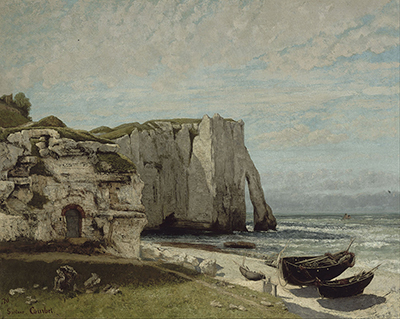Gustave Courbet was a versatile artist but the landscape genre is not what he is most famous for. That said, The Cliffs at Etretat after the Storm is a supreme depiction of a location that has been popular with artists over several centuries.
Many art historians have pointed to the career of Courbet and his fellow Realist artists in laying the groundwork for the later rise of the Impressionists. When you view paintings such as The Cliffs at Etretat after the Storm, as found here, it is perhaps the most obvious link to artists like Claude Monet, who arrived a generation later. Indeed he completed his own version in 1885, titled The Cliffs at Etretat. Other notable artists to have completed landscape paintings in the region of Etretat include Eugene Delacroix with The Porte d'Amont, Etretat plus also several pieces by Eugène Boudin.
The rugged cliffs of this region suited the realism approach of Courbet, allowing him to focus in on every nook and cranny of this beautiful natural phenomenon. Courbet's version found here was completed in 1870, towards the end of his career. It was unusual for Courbet to produce paintings without any human figures, as this was what he was most famous for across the majority of his career. This batch of seascapes, therefore, did push his career into a new direction and he appears to have enjoyed these tranquil locations. Several other works from this period are also included in this website and small fishing vessels were used in some of those too. In this example he has positioned them close to the viewer, which allows him to include more detail on them.
There are also some geese in the foreground which adds a little movement to the scene, but without resorting to human involvement. He features animals regularly in his rural paintings, normally linked to the livelihoods of farmers, but chooses geese in this case. We will never know if they were actually there at the time of the painting, or whether Courbet chose to add them in order to add some extra interest to the overall scene.




